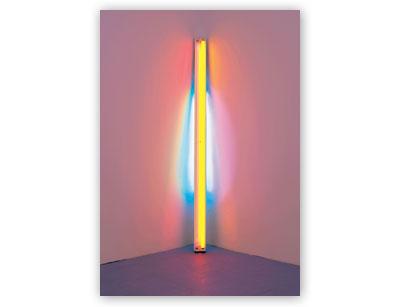Opinion: What Made Dan Flavin Tick?

Initially, it might be difficult to reconcile Dan Flavin’s Expressionist tendencies with his use of the quite literally linear form of long, colored fluorescent lightbulbs to express himself for most of his creative life. Yet a new exhibition of his drawings at the Morgan Library demonstrates that his stylistic influences were varied and well outside of the Minimalist milieu with which he is primarily associated.
For Flavin, who lived in Wainscott and Bridgehampton for much of his later life until his death in 1996, it pays to remember that it was not just the lights and mounts that were a part of the work, but the way the light moved and dissolved the walls behind it, which was the full realization of his vision. While the straight bulbs were structurally and rigidly linear, the light that emanated from them was broadcast in waves that could bend and flow in ways way beyond the stiffness of their source.
The artist was a native New Yorker who was born in 1933, early enough to be a second-generation Abstract Expressionist, but late enough to join those who rebelled against that previous generation. He appears to have straddled both worlds, at least initially, but even in his most fully realized Minimalist works, his painterly use of light could be likened to painters like Mark Rothko.
In his youth he trained for the priesthood, but then left to enlist in the Air Force during the Korean War and studied art during his tour. He came back to New York and studied at the Hans Hofmann School before enrolling at Columbia University to study painting and drawing.
The appeal of Expressionism to the artist is made manifest from the earliest drawings on view in the gallery: beautiful flowing watercolors, quick powerful sketches of artist icons such as Paul Cezanne and Constantin Brancusi, and landscapes in charcoal. A blue grease pencil study of trees is a whirlwind of energy with agitated lines transforming the trees into manic abstractions that resemble flapping birds as well as objects.
Similarly expressive, but employing the Minimalist instinct that would balance his artwork throughout his life, is the drawing of Cezanne, a crisp and confident work employing some of the artist’s own blocky-ness in the beard and shadowing around the face, in a double homage.
One of the show-stopping moments in the exhibit is a work dedicated to Vincent van Gogh. “Vincent at Auvers” is a collection of gestural watercolor and ink drawings on paper that have been collected in a sketchbook. The works have a bold monumentality that transcends their small format and are as powerful as many of the best works of a previous generation.
Some of these early attempts also incorporate text. In the van Gogh book, there is an inscription based on an unsent letter found with the artist after his suicide: “As for my work, I do it at my life’s risk, and half my reason has foundered in it.” In another series he quotes the words of James Joyce in seven poem drawings with watercolor swirls as illustration.
After these atypical works, the show moves quickly into the preparatory drawings for the artist’s earliest light sculptures. At first, they were complicated contraptions: boxes in which to set regular and florescent lightbulbs. Eventually, they evolved into the diagonal works that would define the moment of his artistic maturity. There are several examples in drawing and one example in light form.
These build into more complicated arrangements and schemes for full gallery installations. Sketches for one of his seminal conceptual works, “Monuments to V. Tatlin,” are also on view from his notebooks. Some are little sketches that were part of Flavin’s daily practice. They were made on 6-by-4-inch pages he kept in notebooks he carried with him. Others were executed on more regular 8-by-11-inch pieces of paper.
Later efforts were completed after the sculptures were realized and were used instead to document those works. They would be given to the collector who purchased the sculpture. Eventually, many became separated from their original works and started to be prized as works in their own right. Flavin himself did not execute them, however, most on view were done by members of his family and have a very crisp geometric efficiency, more mechanical than artistic.
Concurrently, however, Flavin was still exploring his own expressive needs in landscape and seascape drawings he made along the Hudson and then on the South Fork. These images of sails and trees continued through the 1970s and 1980s and up through the end of his life. Often no more than one or two lines, he appears to have learned from his light compositions how economical one can be with illustrative elements. He also kept up with his drawings of artists, this time using his friends such as Donald Judd as subjects.
In the last gallery of the show, there is a selection of drawings he collected, including a number of Hudson landscapes by John Frederick Kensett. But there are also Modernists such as Jean Arp and Piet Mondrian. At the preview for the show, the curator Isabelle Dervaux noted that the condition of drawings did not matter to him. Pointing to a badly damaged Kensett, she said it was the image that mattered. For an institution dedicated to the preservation of drawings, she noted that it was highly unusual to hang works with severe damage such as foxing or mildew. Still, their presence does add to the overall understanding of the artist and what made him tick.
The exhibition will be on view through July 1.
